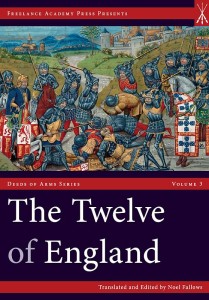Noel Fallows
The Twelve of England
(Freelance Academy Press, 2013) 121 pp. $24.95
Following on two excellent volumes by Steven Muhlberger, Noel Fallows has produced the third volume in Freelance Academy Press’ Deeds of Arms Series. The Twelve of England, a pseudo-historical tale which Fallows argues dates from the second half of the 15th century, offers a glimpse into the chivalric world of late medieval Portugal. The English translation is buttressed with several apparatuses providing a more complete view of the work. Fallows offers an ample introduction to the work, thirty color images, a transcription of the original Portuguese text, a facsimile of the manuscript, genealogical tables, and several maps as part of the volume.
The introduction establishes the necessary framework for understanding the text’s origin, the history of the manuscript, and the nature of the work itself. One of the most impressive of Fallow’s contributions is his distillation of the complex historical background of late 14th and 15th century Iberian military and political affairs into a form that is both understandable and fulfilling to the non-expert in medieval Iberian history. The text itself offers precious little information about the actual historical context in which it exists and so the author’s masterful explanation of this is crucial to understanding The Twelve of England. Moreover, Fallows advances an argument that the text is not simply one more chivalric romance, but represents a fusing of literature and history that illuminates the tangled and murky early history of the late medieval alliance between Portugal and England. Perhaps as importantly, Fallows offers his assessment of the nature of chivalric literature in late medieval Portugal, suggesting that chivalric (or non-chivalric) readers or listeners could insert themselves into the interstices of the story itself. In so doing, readers could vicariously participate in the deeds of the Twelve, lifting their own assessments of themselves and their lineages in the process.
Drawing on his encyclopedic knowledge, Fallows provides an extensive examination of the arms and armor that would have been current in the early 15th century, when the events of the Twelve of England would have actually taken place. A close examination of surviving Milanese armor, complete with photographs, and illustrations of combat, arms, and armor in medieval manuscripts jointly allow the reader to visualize particular aspects described in the text of The Twelve of England. This section will delight military historians who are familiar with the specialist’s terminology and details. The general reader or uninitiated student would find this “Note on Armor” to be impenetrable without the aid of another work offering the language and concepts of medieval arms and armor.[1] This section, though, is not crucial to an appreciation of the larger work, and an uninitiated reader could reasonably pass over this section, though they would certainly miss an enrichingly erudite examination.
The translation itself is precisely what a medieval historian would want it to be. The translation stays true to the literal language of the original Portuguese while also conveying the appropriate tone and feeling. As Fallows notes, The Twelve of England has thematic and typological connections to the wider world of chivalric literature, including the Arthurian tradition and the lais of Marie de France, and these connections will be apparent in the translated text. Similarly, as Fallows notes, the text reads a bit like a chronicle, a tool that the author uses to suggest the historical nature of his story. On this point as well, the translation effectively conveys the literary and rhetorical conventions that the medieval author used in the composition.
Noel Fallows’ edition of The Twelve of England is a truly valuable addition to the corpus of chivalric literature available to English readers. The fact that this text survives in a single manuscript and that it represents the poorly understood world of medieval Portugal highlights the significance of this translation. Fallows has provided not just a translation of the text, but an entire handbook for studying this work. Military historians, historians of chivalry, historians of literature, students, and the general reader will all find this to be a most insightful and useful edition.
Samuel A. Claussen
California Lutheran University
[email protected]
[1]. If one needed to consult such a work, they would be well served by Fallows’ Jousting in Renaissance Iberia (Woodbridge: Boydell, 2010).

